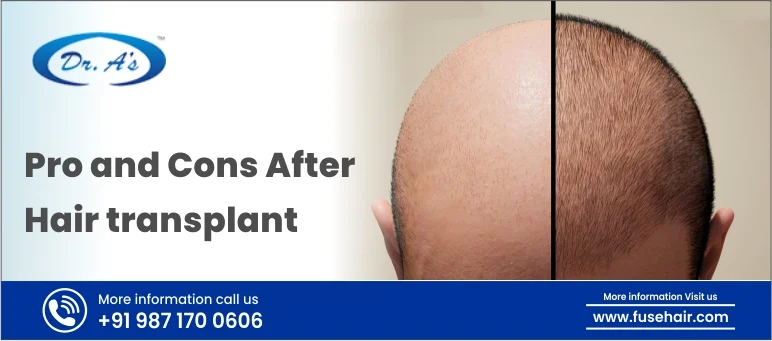
Are you someone who has constantly been suffering from hair loss? Has your hair woes only worsened over time? If so, you have arrived at the right place. You are not alone as thousands of individuals face this distressing experience. They have chosen to have a hair transplant as the way forward. It can make your scalp look like before again and boost your confidence.
With natural-looking results, popular methods like FUE and FUT have been approved by doctors and loved by individuals who have undergone these clinically proven procedures. While you may have heard about them, most of us do not know which option to choose. In this article, we will make a detailed analysis of each of these methods and compare them against each other. Based on that, you will be able to decide which method to opt for.
Understanding FUE and FUT
FUE hair transplant stands for Follicular Unit Extraction, while FUT refers to Follicular Unit Transplantation. Both are hair transplantation methods, but the primary difference lies in how the grafts are harvested and transplanted by both procedures.
For FUE hair transplant, individual hair follicles are extracted from the chosen donor area and then grafted directly into the affected part of the scalp. FUE is ideal for those who want smaller hair transplants or want to sport shorter hair. It does not require any strip excision from the scalp and, hence, is a minimally invasive procedure with a much faster recovery time. The scars are also tiny and round in shape, making them almost unnoticeable.
While in FUT, a strip of scalp is taken containing many hair follicles, which are then dissected into individual follicular units and transplanted at the recipient area. FUT hair transplant is primarily for larger hair, and a higher number of grafts can be transplanted in one session. However, it would require strip excision from a skin patch and can leave a noticeable linear scarring.
Comparing FUE and FUT
To simplify it further, we will make a FUE vs FUT comparison and help you choose the right hair transplant. The best hair transplant method for you should cover all aspects like methodology and harvesting, scarring, recovery and downtime, the naturality of results and suitability, and last but not least, the cost of hair transplant. Once you have gone through all the differences between the two, you will know which one is the best hair transplant method for you.
Methodology and Harvesting
FUE
In FUE, your doctors will go for your hair one by one. Imagine using tweezers to pluck hairs. We use tiny tools, like little punches, to grab individual hair follicles from the sides and back of your head. These tools create tiny holes, like pinpricks, where we take the hair out. We choose healthy and strong hairs that won’t give up later. It’s like carefully picking grapes from a vineyard.
FUT
Now, FUT is a bit different. Instead of plucking one at a time, your doctor will cut out a strip of your scalp, usually from the lower back of your head. This strip has lots of hair on it. Think of it like slicing a piece of cake. Then, we divide that strip into small groups, like little hair families, using microscopes. These groups are called follicular units. It’s like cutting a big cake into slices and then dividing those slices into pieces.
What is the difference?
The big difference here is that FUE is picking individual units, while FUT is taking a patch and dividing it into sections and then again into smaller bits. Both methods get us precious hair, but they do it in their unique ways.
Scarring
FUE
When you opt for FUE, the scars are quite small and not very noticeable. Your doctor will create these little dot-like scars where each hair was taken from. These scars are usually about the size of a pen tip. They’re similar to tiny freckles on your skin – hardly visible, especially when your hair grows back. It’s like having a few tiny marks that aren’t very noticeable to others.
FUT
Now, with FUT, it’s a bit different. This method leaves you with a longer, straight scar where they took the strip of scalp. This is called linear scarring. It’s like a line on a piece of paper. This scar can be more noticeable, especially if you prefer shorter hairstyles. It’s a bit like having a visible seam on a piece of clothing. However, If you are someone who prefers growing longer hair, the scar can be easily covered and go unnoticed by the naked eye.
What is the difference?
So, to put it plainly, FUE gives you small, hardly noticeable scars, while FUT leaves a longer, more visible scar. The choice depends on where and how you’d like to have those scars, and your doctor can help you decide which one suits your preferences best.
Recovery and Downtime
FUE
Recovery with FUE is usually quicker. You can get back to your regular activities within a few days because there are no stitches. Any swelling or discomfort is minor, and you can manage it easily. This means you won’t have to put your life on hold for long.
FUT
FUT may require a bit more time for recovery. Since there are stitches involved, you might experience more discomfort in the beginning. Hence, you’ll need to take it easier for a bit longer, maybe a week or more.
What is the difference?
In short, FUE offers a shorter downtime because there are no stitches, making it easier for you to go back to your routine sooner. FUT, however, may require more patience during the recovery process due to the stitches. Your doctor can guide you on which option aligns better with your schedule and preferences.
Naturalness of Results
FUE
With FUE, you can expect very natural results. The reason is that your doctor can place each hair exactly where it should be. This precision resembles how your original hair grows. Moreover, FUE typically has a high graft survival rate, meaning most of the transplanted hairs will thrive. Thus, you get an overall appearance that blends seamlessly with your existing hair, making it hard for anyone to tell the difference.
FUT
FUT can also provide natural results when done well. However, because they involve a group of hairs, there might be a little less control over the way they grow. Nevertheless, a skilled surgeon can make sure your hairline and overall appearance look as natural as possible.
What is the difference?
In simple words, both FUE and FUT can give you natural-looking results. FUE’s advantage lies in precise placement and a high graft survival rate. FUT, while working with groups of hairs, can still achieve a natural appearance with the right surgical technique. Your doctor will ensure you get a result that makes you feel confident and natural.
Suitability for Different Cases
FUE
FUE hair transplant is a good option for people who have donor area limitations. This is because the precision in FUE allows for the careful extraction of individual hair follicles, making the most of the limited donor hair available. However, FUE may not be the best option for extensive hair loss because it can be more time-consuming and may not yield as many grafts in a single session compared to a FUT transplant. Thus, its suitability depends on your specific circumstances and preferences.
FUT
FUT hair transplant is well-suited for people who experience extensive hair loss. It yields good results because it can harvest a large number of grafts in a single surgery. This is particularly encouraging when you have significant hair loss to address within a shorter duration. However, FUT may not be the best choice for individuals with donor area limitations. It involves removing a patch of the scalp, which could deplete the available donor hair. Therefore, the suitability of FUT depends on the extent of hair loss and the condition of your donor area.
What is the difference?
In short, if you have very limited donor hair, FUE is the better option. If you are someone who is targeting to treat extensive hair loss, choose FUT.
Cost Considerations
FUE
FUE is often a bit costlier compared to FUT. The main reason is that FUE can be more time-consuming for the surgical team, as they extract individual hair follicles one by one. Thus, the cost can be higher because of the additional time and effort involved in the procedure.
FUT
FUT tends to be somewhat more budget-friendly. Since it involves removing a strip of scalp with hair, it’s a bit quicker in the operating room, which can lead to lower costs. However, remember that while it might save you some money initially, you might need to consider the potential cost needed for future procedures if you experience more hair loss, especially if you’re younger.
What is the difference?
So, in short, FUE can be pricier because it takes more time, while FUT is generally more cost-effective. However, it’s essential to consider the long-term picture and consult with your doctor to weigh the budgetary aspects against your goals and expectations when choosing the right hair transplant method for you.
Conclusion
To summarize FUE and FUT, if you decide to transplant hair, we can say that the choice relies upon the recipient and whatever is best suited for them. Firstly, the harvesting and transplanting methods will differ as FUE requires individual unit extractions, and the latter involves a whole patch of skin.
Scarring is also a factor, as FUT leaves a much more noticeable scarring than FUE. Even in case of recovery, FUE wins the race as FUT would need some time for the stitch to heal. Compared to FUT, FUE also tends to give more natural-looking hair. However, FUT is good for extensive hair loss and is somewhat cheaper than FUE.
If you’re confused about which hair transplant procedure to undergo, consult Dr. Arvind Poswal. With decades of experience and enhanced knowledge, he will analyze your hair loss pattern and condition and suggest a suitable option for you. He uses the latest technologies and FDA-approved equipment to perform every surgery and ensure effective outcomes.
Frequently Asked Questions
-
Which method, FUE or FUT, leaves more noticeable scars?
FUT leaves more noticeable scars. A linear scar is formed due to a patch of skin being taken. However, the scar can be managed if the recipient grows longer hair.
-
Does one method have a higher success rate in terms of graft survival?
The graft survival rate depends upon the surgeon’s precision. If your doctor is well-trained and has good expertise, then the graft survival rate can be as high as 90% for both FUE and FUT.
-
Is one method better for individuals with extensive hair loss?
FUT is usually better for individuals with extensive hair loss as it transplants a larger number of grafts in a quicker time.
-
Do FUE and FUT result in different levels of discomfort or pain during recovery?
Yes, FUT can be more discomforting and painful compared to FUE, as the former requires a strip excision and a subsequent stitch. There may be some swelling or redness with FUT, but it subsides over time.
-
Are there cost differences between FUE and FUT?
Yes, there are cost differences involved. FUE is more pricier compared to FUT. The former is more time-consuming for doctors and involves the utmost precision; hence, the overall cost is higher.






























































































































































